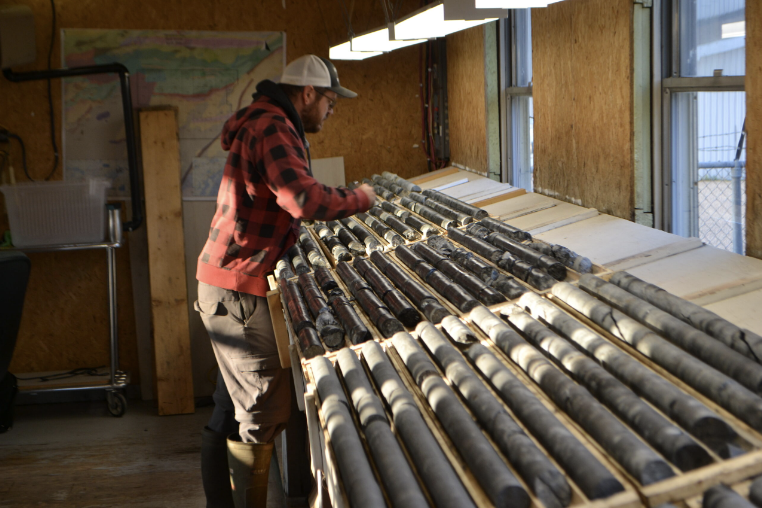MONT SORCIER

Location
Quebec, Canada
Ownership
100%, 1,919 ha concession package
Status
Exploration/Development stage
Deposit Type
Magnetite Iron Ore and Vanadium Deposits
Infrastructure
Road, Rail, Ports, skilled labour and low-cost Hydro Power in place with available capacity
LoM Average annual production
Measured & Indicated
Inferred Resource
Property Summary
The Mont Sorcier Iron ore property hosts a large high quality Iron resource with significant and extractable Vanadium in a top tier mining jurisdiction. The Mont Sorcier Iron-Vanadium deposit consists of a North and South deposit that boasts exceptionally low Titanium content, allowing for simple extraction of the Vanadium metal by a blast furnace, making the deposit and possible product unique in the world markets.
Excellent Mining Jurisdiction
Located just 18 km outside of Chibougamau, Quebec by road Mont Sorcier boasts impressive existing infrastructure in one of the world’s top tier mining jurisdictions.
The Mont Sorcier property is less than 10 km from low-cost provincial Hydro along maintained roads. Roads lead directly from Mont Sorcier to the rail head less than 20 km away. The railway is underutilized by approximately 45% and provides direct access to several deep water ports in Quebec.
Located north of the 49th parallel, Mont Sorcier is eligible for support by the Quebec government through Plan Nord, a program focused on supporting mining and development in northern Quebec.

Large Resource Tonnage
Mont Sorcier boasts an impressive 678.5 Mt Indicated and 546.6 Mt Inferred with the potential for expansion along strike, where the deposit’s magnetic anomaly continues, and at depth. Providing a robust base to support production for decades to come.

High Quality Iron Ore
Low titanium (< 2%) and deleterious elements such as phosphorus, aluminum, and silica speak to the high quality of Iron Ore and Vanadium present at Mont Sorcier as observed in the NI 43-101 resource estimate for Mont Sorcier in Table 2.
Table 2: NI 43-101 compliant resource estimate for Mont Sorcier (May 2021)*

Notes to accompany the Mineral Resource Estimate:
- The independent and qualified persons for the mineral resource estimate, as defined by NI 43-101, are Marina Iund, P.Geo., Carl Pelletier, P.Geo., Simon Boudreau, P.Eng. all from InnovExplo Inc. and Mathieu Girard P.Eng from Soutex. The effective date is June 6th, 2022.
- These mineral resources are not mineral reserves, as they do not have demonstrated economic viability. The mineral resource estimate follows current CIM definitions and guidelines.
- The results are presented undiluted and are considered to have reasonable prospects for eventual economic extraction by having constraining volumes applied to any blocks using Whittle software and by the application of cut-off grades for potential open-pit extraction method
- The estimate encompasses two (2) deposits (North and South), subdivided into 8 individual zones (7 for North, 1 for South).
- No high-grade capping was applied.
- The estimate was completed using sub-block models in GEOVIA Surpac 2021.
- Grade interpolation was performed with the ID2 method on 4 m composites for the North deposit and on 10 m composites for the South deposit.
- The density of the mineralized zones was interpolated with the ID2 method. When no density analysis was available, the density value was estimated using linear regression with Fe2O3 analysis. For the unmineralized material, a density value of 2.8 g/cm3 (anorthosite and volcanics), 3.5 g/cm3 (Massive sulfide formation) and 2.00 g/cm3 (overburden) was assigned.
- The mineral resource estimate is classified as Indicated and Inferred. The Inferred category is defined with a minimum of two (2) drill holes for areas where the drill spacing is less than 400 m, and reasonable geological and grade continuity have been shown. The Indicated category is defined with a minimum of three (3) drill holes within the areas where the drill spacing is less than 200 m, and reasonable geological and grade continuity have been shown. Clipping boundaries were used for classification based on those criteria.
- The mineral resource estimate is locally pit-constrained for potential open-pit extraction method with a bedrock slope angle of 50° and an overburden slope angle of 30°. It is reported at a rounded cut-off grade of 2.30 % Weighted recovered Fe (Fe % x Process Recovery). The cut-off grade was calculated for the concentrate using the following parameters: royalty = 3%; mining cost = CA$3.30; mining overburden cost = CA$2.45; processing cost = CA$3.62; G&A = CA$0.75; selling costs = CA$58.36; Fe price = CA$190/t; USD:CAD exchange rate = 1.3; and mill recovery = 100% (concentrate). The cut-off grades should be re-evaluated considering future prevailing market conditions (metal prices, exchange rates, mining costs etc.).
- The number of metric tonnes was rounded to the nearest thousand, following the recommendations in NI 43-101 and any discrepancies in the totals are due to rounding effects.
- The authors are not aware of any known environmental, permitting, legal, title-related, taxation, socio-political, or marketing issues, or any other relevant issue not reported in the Technical Report, that could materially affect the Mineral Resource Estimate.
Note that the Inferred in the current table are slightly different from those disclosed on June 9, 2022. In the course of writing this technical report, some adjustments were made to some deep inferred blocks in the block model resulting in a small decrease of the inferred MRE. The total has gone from 595 Mt to 547 Mt total inferred. The lost tonnage of Inferred is transferred to exploration potential.
Technical Reports
NI 43-101 Technical Report
Preliminary Economic Assesment (PEA) for the Mont Sorcier Project – Quebec, Canada, Sept 8, 2022
NI 43-101 Technical Report
Mineral Resource Estimate for the Mont Sorcier Project, Province of Quebec, Canada, July 22 2022
NI 43-101 Technical Report
Mont Sorcier Project, Province of Quebec, Canada, June 25 2021
NI 43-101 Technical Report
Premliminary Economic Assesment (PEA) of the Mont Sorcier Project, Province of Quèbec, Canada, April 2020
NI 43-101 Technical Report